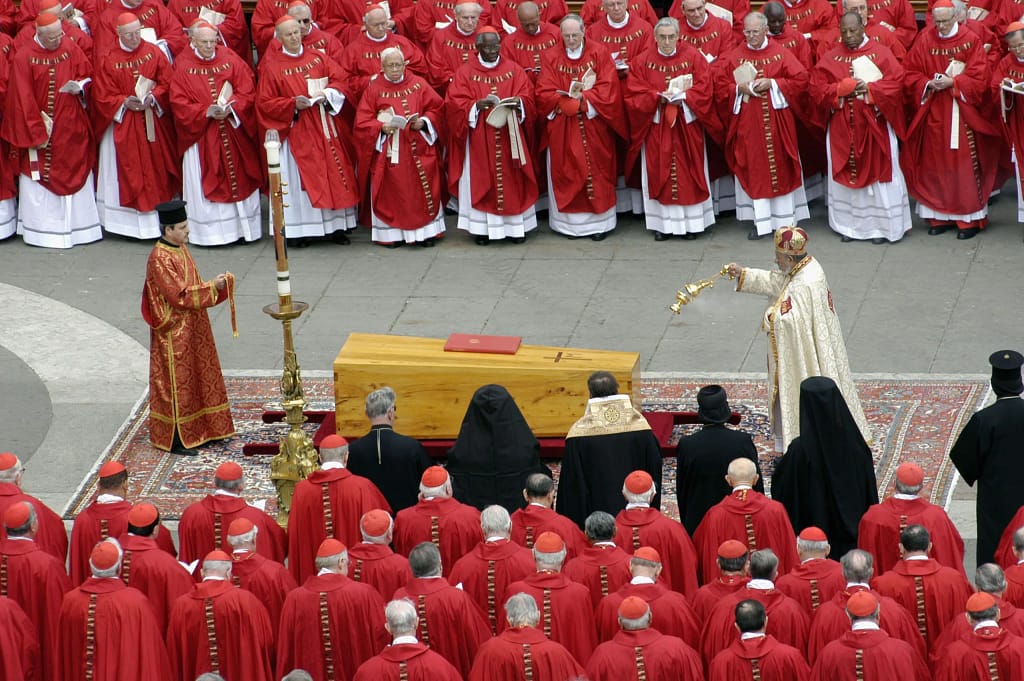Inside the centuries-old rituals, protocols, and logistics behind the passing of a pope.
Vatican City — When a pope passes away, the world pauses. But behind the walls of the Vatican, a highly choreographed series of ancient rites and modern logistics swings into motion — a process shaped by tradition, refined by history, and powered by spiritual reverence. With the recent death of Pope Francis, the Vatican has once again activated its solemn, sacred protocol: Ordo Exsequiarum Romani Pontificis — the Order of Papal Funerals.
This extraordinary moment in Catholic history reveals a rare convergence of faith, formality, and statecraft. The funeral of a pope is not just a religious event — it is a global phenomenon that draws millions and engages leaders, believers, and media from every corner of the world.
The First Hours: Death of a Pontiff
The moment the pope is declared deceased, the Camerlengo — currently Cardinal Kevin Farrell — takes charge of the interregnum. He officially confirms the pope’s death, traditionally calling out the deceased pontiff’s baptismal name three times before declaring, “The pope is truly dead.”
The pope’s Fisherman’s Ring, the gold seal of papal authority, is ceremonially crushed to symbolize the end of his governance. The Vatican offices close, flags are lowered to half-mast, and bells toll across Rome.
The Nine Days of Mourning – “Novemdiales”
The Vatican observes nine days of mourning known as Novemdiales. Each day includes specific prayers, masses, and processions leading up to the funeral. Cardinals from around the world arrive in Rome to participate in these liturgies and begin preparing for the conclave if the pope has died in office.
“These nine days are not just for mourning — they are a spiritual bridge between the Church and the next era of leadership,” said Archbishop Luis Tagle of the Philippines.
Lying in State: A Final Farewell
The pope’s body is dressed in red liturgical vestments and placed in a closed coffin within St. Peter’s Basilica, where it lies in state for public veneration. Throngs of mourners — from presidents to pilgrims — pass silently by the casket, offering flowers, prayers, and tears.
The basilica remains open 24/7 during this period, with Swiss Guards standing vigil in ceremonial armor. Cameras from around the world capture the tender moments of homage, from weeping children to heads of state.
Crafting the Coffin: Three Layers of Tradition
According to tradition, the pope is buried in three coffins, each with specific symbolism:
- Cypress Wood – Symbolizing humility and simplicity.
- Lead – To preserve the remains and inscribe the details of the papacy.
- Elm or Oak Wood – For strength, dignity, and final sealing.
Placed within the coffin is a sealed parchment scroll recounting the pope’s life and accomplishments, alongside commemorative coins and medals from his papacy.
The Funeral Mass: A Global Gathering
The funeral typically takes place in St. Peter’s Square and is led by the Dean of the College of Cardinals — currently Cardinal Giovanni Battista Re. For Pope Francis, a deeply pastoral figure, the service is expected to emphasize compassion, justice, and care for the marginalized — themes central to his papacy.
Liturgical music, prayers in multiple languages, and the symbolic final commendation — where incense rises and the coffin is blessed — bring the Catholic faithful together in one resounding goodbye.
Burial in the Vatican Grottoes
Following the Mass, the pope’s body is carried into the crypt beneath St. Peter’s Basilica. He is laid to rest among the tombs of his predecessors, near the bones of St. Peter, the first pope. If he left special burial wishes, such as a specific location or epitaph, the Vatican honors them.
“The tomb of a pope is not a monument to power,” remarked Vatican historian Sister Helena Costa. “It is a witness to a life spent in service of Christ and the Church.”
Security, Diplomacy, and Logistics
A papal funeral is also a diplomatic affair. The Vatican coordinates with the Italian government, Interpol, and foreign embassies to ensure the safety of attendees — including heads of state, royal families, and religious leaders. A no-fly zone is imposed over Rome, and thousands of security personnel are deployed across key sites.
Additionally, translators, ushers, emergency responders, and volunteers from religious communities all work seamlessly behind the scenes.
Global Voices: Reflections from the Faithful
@CatholicPilgrim77 (Brazil): “We waited 12 hours in line, and it was worth every minute. To see him one last time — our humble shepherd.”
Rev. John McNamara (Ireland): “This funeral is a catechism in itself. It teaches us how to live and how to let go.”
Laila Mohammed (Egypt): “I am Muslim, but I admired Pope Francis. His funeral honors all humanity.”
@StPeterFanPage (Italy): “The Vatican has done this for centuries — but it never stops being moving. Rome is grieving, and praying.”
A Ceremony of Continuity and Change
While the papal funeral follows time-honored structure, each pope leaves his own mark on the ritual. Pope Francis, with his love for simplicity and inclusion, has inspired a farewell that honors both tradition and transformation — a reflection of the Church he helped reshape.
As the world prepares to lay him to rest, millions are not just saying goodbye to a man, but to a messenger of hope, humility, and healing.
*“Even in death,” said Vatican spokesman Matteo Bruni, “he brings the world together — not in sorrow, but in sacred remembrance.”

